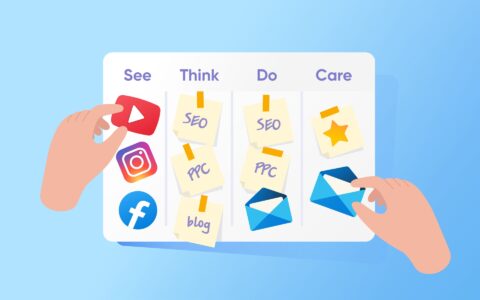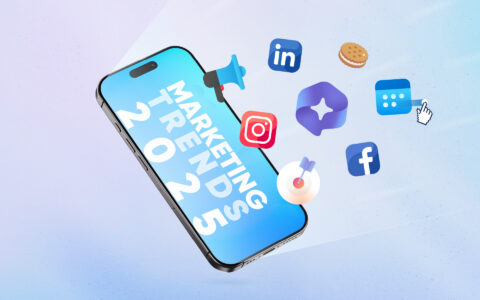
Our experience is that small and medium businesses usually don’t have their own Marketing Departments and their marketing is neither systematic, nor well-guided.
It is often done by the CEO or Managing Director, Business Director, or, with all due respect to this position, the Secretary. Marketing is often performed without the necessary knowledge, means, resources, and well managed processes. Our aim is to bring fresh ideas and inspiration on how to be effective in marketing and advertising.
Every marketing, advertising, or PR project has to begin with setting the right goals. SMBs typically lack a complex and systematic approach and important details are not considered. The importance of such decisions is not always understood and sometimes, we can see that money is being saved in the wrong place.
Today, we will focus on what goals should be about, what they should contain, and why we create them in the first place. We are of course choosing the most essential information as a small introduction into this topic.

MARKETING AND COMMUNICATION GOALS
How to begin? Define your goals – realistic, not your wildest dreams
Starting out in the jungle of marketing means to set the goals of your way first. Every manager has a different opinion. The Business Director needs a quick sales growth of X % in a short time period, therefore he recommends sales. The Marketing Director wants to create a better brand image and to invest into creative advertising. The Sales Representative needs to sell immediately. The Project Manager wants to have a satisfied client and a good commission profitability. Each and every one of them will fight for their outlook. That can ruin all the effort with no long-term concept being set. These goals reflect the strategic goals of the company.
We have two types of goals over here – marketing and communication. How are they different and how do we define them?
Marketing goals – the exact number and correct resources
It is easy to recognize the marketing goals – you can count and measure them. It is almost always represented by a number – of sold products, of deals or orders, of showrooms, of Sales Reps, of customers... These are often goals that compare us to our competitors on the market: market share, sales growth, etc. (We know that the data is not always publicly accessible and sometimes this is more of a guess).
There are different approaches on setting our goals. A lot of companies, for example, want to sell as much as possible. Therefore, their goal is to maximize the rise of sales, so they give great discounts, but the advertising overheads can be too big, and profitability is near zero. Other companies sell little products and try to maximize the margins, so they prefer high process and their revenue is higher. Be careful on this one – often, the task can be rising the sales by 20 %, however, a part of the plan is cutting down the marketing expenses! Or the client wants a video that will go viral and become extremely popular on YouTube and social media, the budget is small and the whole job is supposed to be done by a cheap student with professional skills. Good morning, marketing is no fairytale!
Communication goals – a long journey
It’s impossible to count your communication goals exactly – it is a difficult category to manage.
The best strategy is to build your brand image – without that done, no customer will write your brand down on their shopping list. That is true in B2B as well – unless the client knows the brand well, they won’t contact them. Take a look at how people write their shopping lists. Either they only write product categories, for example: “bread”, or “Sara Lee”. When people only write the category, they will buy the cheapest product, or the one with the best advertisement, package, or the one recommended by the shop assistant. The ideal situation for a brand is to get listed on the shopping list, that is a sign of loyalty. We can say that the customer becomes an advertisement for the branded product himself!
Another step is building the brand identity. It’s not just a good logo, slogan, and corporate colors, but the whole visual style. It’s not a good idea to save money on this – this is how you differentiate from your competition. Saving money on your logo and graphics means risking your brand will vanish among other others. Even the color of your company cars is an important part of your identity – it is a constant form of advertising on the road.
When building the brand identity, it is crucial to differentiate between what the company says about itself and what the customers say about it, because it can also be the opposite. Key is a unified communication line. That means a constantly developing story, easy to understand for the customer. That’s why storytelling has become so popular in marketing.
MARKETING
Internal processes while creating marketing communication - human factor is crucial
Marketing is about people and all the activities while creating marketing communication have to be described as processes. Those processes need to be optimized. That’s not a one-time act that you finish, and mark as done. It’s a never-ending job of developing the work effectivity of your team. Therefore, it’s a very important job generating results among the company.
The praxis
It is necessary to set the rights and responsibilities for each member of the team. Often, somebody gives an inaccurate brief, but he later criticizes the creative work of the marketing team. It is essential that everyone stays in the area of their own expertise.
The more accurate the brief, the easier it is to build a solution upon it. Marketing is a hard job.
What never helps is negative feedback without concrete points. Instead of saying “I don’t like this,” creative teams need to hear exactly what should be changed, whether it is the style, content, or some parts in particular. Teams need to find relevant solutions instead of criticizing the aspects of one’s personal style and preference. Everything needs to reflect the strategy chosen for the particular client.
Target group and segmentation – target the correct people
Marketing always addresses a particular group of customers. It used to be only the primary target group, however, nowadays there are many more specific target groups. We have influencers (mostly present on YouTube, Facebook, and Instagram), brand ambassadors, etc. Also, the company employees are a part of this, as well as the job candidates. We have business partners, the public, the professionals, institutions, or government. There are also journalists, because being praised in the media is a free advertisement for a brand!
The best way of describing a target group is in the context of the customer purchasing process and its phases. We need to describe all the points of a customer’s interaction with the brand – before the purchase, while purchasing, and after as well.
Current brand position on the market compared to the competition – SWOT is still worth the elaboration
The current situation can be evaluated through SWOT analysis. The weaknesses can be changed into opportunities! Your company will need to face threats, as future comes faster in the online world. Opportunities help us find areas which are worth spending time on. Your strengths can be used for creating the marketing strategy.
SWOT can be looked upon from the outside, meaning the market and competition, or the inside, meaning the view of the employees. The second approach shows the motivation of employees and their goodwill toward the customers.
You can use the concept of the marketing mix as well and describe the 4 Ps:
- Product or service
- Price
- Promotion or marketing communication
- Place
Nowadays, we recognize more than 4 Ps, usually 6. We include People – those who help create the success of the brand by their work approach. Another P stands for Processes.
Based on that, we can build our basic marketing strategy.
MARKETING and COMMUNICATION STRATEGY
Marketing strategy
The aim of a marketing strategy is to accomplish your long-term goals. That should be done through effective investments and human resources. Long-term goals are typically keeping clients as well as getting new ones, keeping the market share, or a competitive advantage. As the strategy is supposed to fulfill overall long-term company goals, it should focus on fulfilling the customers’ expectations, speaking of current as well as new ones. A part of it is aiming on our target groups through a suitable marketing mix.
Simply put, we need to think through our possibilities to keep the success going. What we can use, what our budget is, what people and suppliers we want to collaborate with, and how we will reach the customers.
Communication strategy – brand building
Communication strategy is a key part of the marketing strategy. This is the place for brand management. Keep in mind this is not a half-year plan, but a real long-term view for many years ahead!
These are the separate categories a marketing strategist has to clarify first if they wish to create a strong brand:
- Identity
- Vision
- Mission
- Position
- Essence
- Character
Companies nowadays also use the brand archetypes, meaning a truly complex approach toward brand building.
Brand image can be divided into the one created by the company and the one perceived by the public – these two perceptions can differ dramatically! Another chapter is partial strategy for these categories of integrated marketing communication: HR marketing – employer’s brand building, sponsoring, and charity, CSR, PR. Survey and market survey are important too, as well as feedback.
Communication channels – choosing the right media to reach your target group
If you understand your target group, you also know what media and communication channels people use, read, and listen to. There is no use in guessing, the times of huge print circulation is gone and people spend their time more and more on the internet and social media. Television still has a good reach; however, the price may not be acceptable for SMBs. The radio can find its listeners for a good price, but a right station and time have to be found.
Yes, in order to communicate in an effective way, you need to know the price for reaching the target group and most importantly create attractive content that will get shares on social media without the necessity of paying loads for promotion.
Conclusion – a good strategy is the basis for brand and company market survival
Maybe now you are asking yourself what the point is. Isn’t it better to save money and instead of creating a strategy, write a modern short text and a phrase like: “We are a young and dynamic company trying to improve the products and services” or “We are flexible and customer-oriented”? This cliché fits half the companies on the market. You don’t want to drown among the boring, empty phrases.
A brand should be based on a unified, complex strategy, because without it, it is impossible to create a unified communication line and there is a threat of broken brand identity. What does that really mean? Every advertisement has a different topic and it is impossible for the customer to identify the brand at first sight. In today’s world of huge competition, that is a road toward a quick suicide, because the company becomes unrecognizable among its segment. To make matters worse, the customers won’t understand the brand’s added value and so it will never become a favorite brand, therefore, the customer satisfaction cannot be reached. To have a strategy means to speak clearly and to have something to say, because the content is what sells the best!
You may be asking how to create such a company strategy when you haven’t even had time to finish 10 other priorities. Don’t worry, strategy is nothing to be afraid of, it’s a space for inspiration and creativity. The solutions are the following – you will accomplish this on your own, having enough time for lectures and learning, or you can pay an external consultant, as there are so many of them on the market nowadays. Especially if you are a small company, you might be happier getting a solution externally rather than creating a marketing department among your company. This way, you can keep your focus on your business, not on the marketing!
Thank you for reading the brief introduction until this point. The topic is very broad and it deserves a thick book. This article should be understood as some fresh inspiration for your beginning.
The author of this article is an external partner of eWay-CRM, Vit Balousek, lecturer and consultant.










